NIOS Class 12 Data Entry Operations Chapter 1 Basics Of Computer Solutions to each chapter is provided in the list so that you can easily browse throughout different chapters NIOS Class 12 Data Entry Operations Chapter 1 Basics Of Computer and select need one. NIOS Class 12 Data Entry Operations Chapter 1 Basics Of Computer Question Answers Download PDF. NIOS Study Material of Class 12 Data Entry Operations Notes Paper 336.
NIOS Class 12 Data Entry Operations Chapter 1 Basics Of Computer
Also, you can read the NIOS book online in these sections Solutions by Expert Teachers as per National Institute of Open Schooling (NIOS) Book guidelines. These solutions are part of NIOS All Subject Solutions. Here we have given NIOS Class 12 Data Entry Operations Chapter 1 Basics Of Computer, NIOS Senior Secondary Course Data Entry Operations Solutions for All Chapter, You can practice these here.
Basics Of Computer
Chapter: 1
DATA ENTRY OPERATIONS
INTEXT QUESTIONS
1. What are the five basic operations performed by the computer?
Ans. The five basic operations performed by the computer are: Input, output, control unit, memory unit and arithmetic logic unit (ALU).
2. Define ALU, CU and CPU.
Ans. Arithmetic Logic Unit (ALU): The major operations performed by the ALU are addition, subtraction, multiplication, division, logic and comparison.
Control Unit (CU): The process of input, output, processing and storage it performed under the supervision of a unit called Control Unit.
Center Processing Unit (CPU): The ALU and the CU of a computer system are jointly known as the central processing unit (CPU) we may call CPU as the brain of any computer system.
3. Choose the correct answer:
(a) The task of performing arithmetic and logical operations is called:
(i) ALU.
(ii) Editing.
(iii) Storage.
(iv) Output.
Ans. (i) ALU.
(b) The ALU and CU Jointly are known as:
(i) RAM.
(ii) ROM.
(iii) CPU.
(iv) None of above.
Ans. (iii) CPU.
(c) The process of producing results from the data for getting useful information is called:
(i) Output.
(ii) Input.
(iii) Processing.
(iv) Storage.
Ans. (i) Output.
INTEXT QUESTIONS
4. Write True or False for the following:
(a) Mouse is an output device.
Ans. False.
(b) OCR stands for Optical Content Reader.
Ans. False.
(c) LCD Monitor is used in notebook computer.
Ans. True.
(d) Speed of DOT Matrix Printer is measured in Characters Per Second.
Ans. True.
(e) Plotters are used to produce high quality drawings and images, such as construction plans for buildings or blueprints for mechanical objects.
Ans. True.
INTEXT QUESTIONS
5. Write True of False for the following:
(a) Operating system (OS) is an application Software.
Ans. False.
(b) High level languages are easy to program than low level language.
Ans. True.
(c) Computer language FORTRAN is used to solve Scientific and Mathematical problems.
Ans. True.
(d) C is an object oriented programming language.
Ans. False.
(e) Compiler converts high level languages into machine language.
Ans. True.
TERMINAL QUESTIONS
1. What is a computer? Draw a blocK diagram to illustrate the basic organisation of a computer system and explain the functions of various units.
Ans. Computer: Computer is a device that transforms data into meaningful information. Data can be anything like marks obtained by we in various subjects. It can also be name, age, sex, weight, height, etc. of all the students in a class.
Computer can also be defined in terms of functions it can perform.
A computer can:
(i) accept data.
(ii) store data.
(iii) process data as desired.
(iv) retrieve the stored data as and when required. and
(v) print the result in desired format.
The major characteristics of a computer are high speed, accuracy, diligence, versatility and storage.
Computer Organisation: The block diagram of computer is shown in give figure.

Fig. Block diagram of computer Organisation.
The computer performs basically five major operations of functions irrespective of their size and make.
These are:
(i) It accepts data or instruction by way of input.
(ii) It stores data.
(iii) It can process data as required by the user.
(iv) It gives results in the form of output. and
(v) It controls all operations inside a computer.
We discuss below each of the these operations:
(i) Input: This is the process of entering data and programs into the computer system.
(ii) Control Unit (CU): The process of input, output, processing and storage is performed under the supervision of a unit called Control Unit. It decides when to start receiving data, when to stop it, where to store data, etc. It takes care of step by step processing of all operations in side the computer.
(iii) Memory Unit: Computer is used to store data and instructions.
(iv) Arithmetic Logic Unit (ALU): The major operations performed by the ALU are addition, subtraction, multiplication, division, logic and comparison.
(v) Output: This is the process of producing results from the data for getting useful information.
The ALU and the CU of a computer system are jointly known as the central processing unit (CPU). We may call CPU as the brain of any computer system.
2. What is an input device? Briefly describe various important input devices.
Ans. Input Devices: Input devices accept data and instructions from the user. Following are the examples of various input devices, which are connected to the computer for this purpose.
(i) Keyboard.
(ii) Mouse.
(iii) Light Pen.
(iv) Optical/magnetic Scanner.
(v) Touch Screen.
(vi) Microphone for voice as input.
(vii) Track Ball.
(i) Keyboard: A keyboard is the most common input devices. Several kinds of keyboards are available, but they resemble each other with minor variations. The keyboard in most common use is the QWERTY board. Generally standard keyboard has 104 keys. In these keyboards, the cursor control keys are duplicated to allow easier use of the numeric pad.
(ii) Mouse: Mouse is an electro-mechanical, hand-held device. It is used as pointer. It can perform functions like selecting menu commands, moving icons, resizing windows, starting programs and choosing options.
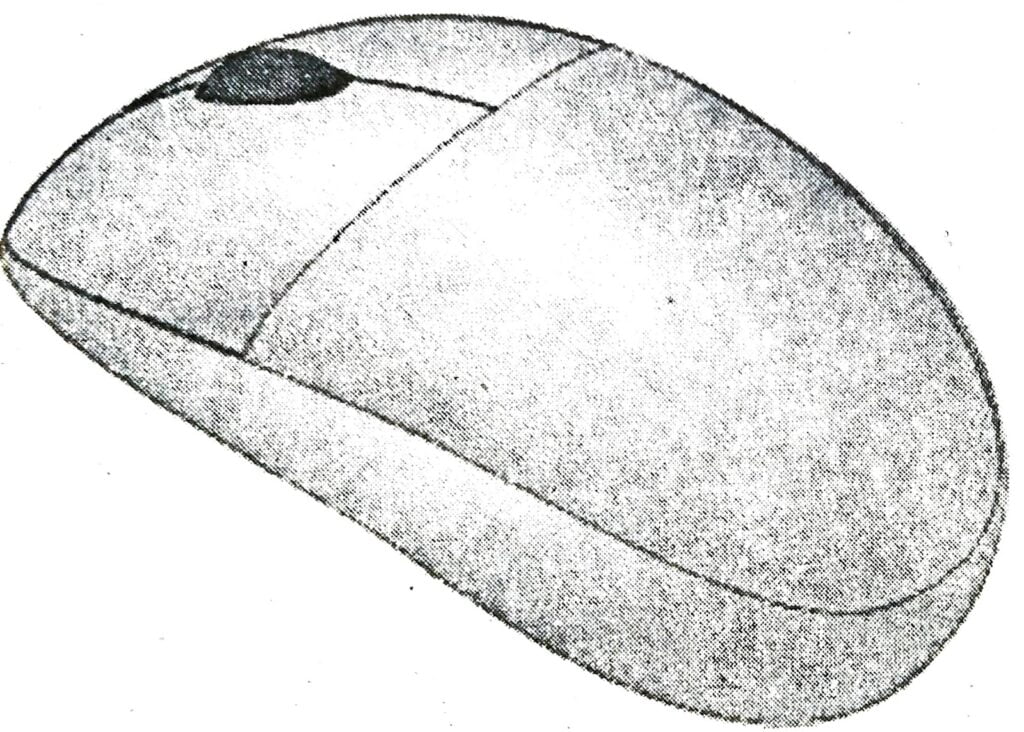
(iii) Light pen: An input device that utilizes a light- sensitive detector to select objects on a display screen. A light pen is similar to a mouse (as shown in figure), except that with a light pen you can move the pointer and select objects on the display screen by directly pointing to the objects with the pen.
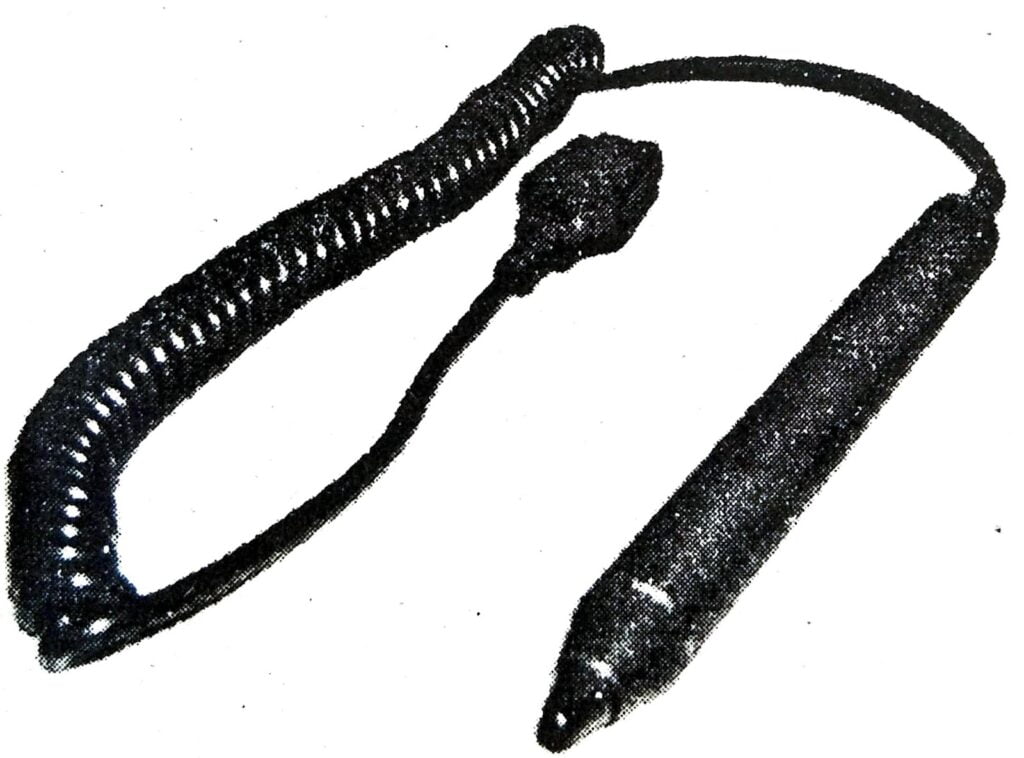
(iv) Optical Scanner: These devices are used for automatic data collection. The devices of this category completely eliminate manual input of data. For example, the bar-code reader is actually just a special type of image scanner. An image scanner translates printed images into an electronic format that can be stored in a computers memory and with the right kind of software, one can alter a stored image. Another example of scanner is optical character recognition (OCR) device, used by banks to convert the scanned image of a typed or printed page into text that can be edited on the computer.

(v) Touch Screen: Touch panel displays and pads are now being offered as alternatives to keyboard. Here the input can be given through the computer screen, that accepts the input through monitor; users touch electronic buttons displayed on the screen or they may use light pen.
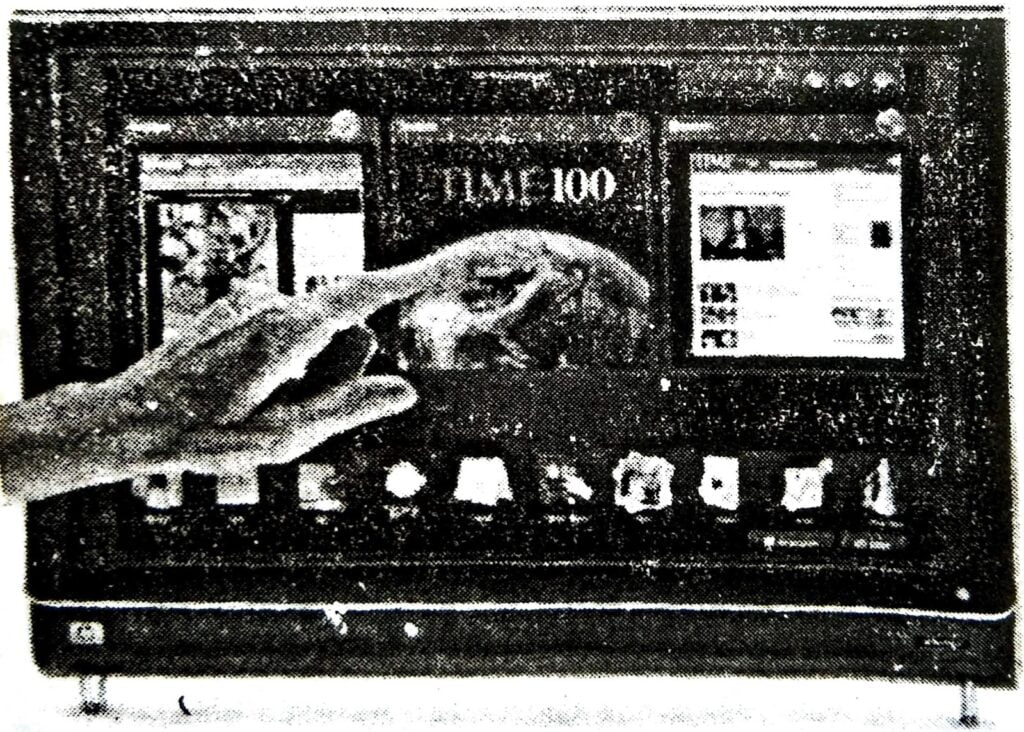
(vi) Microphone: Microphone is an input device, which takes voice as input. The voice communication is more error-prone than information through keyboard.
There are two types of microphones available:
(a) Desktop Microphone
(b) Hand held Microphone.
(vii) Track Ball: Trackball, a pointing device, is a mouse lying on its back (as shown in figure). To move the pointer, you rotate the ball with your thumb, your fingers, or the palm of your hand. There are usually one to three buttons next to the ball, which you use just like mouse buttons.
The advantage of trackballs over mouse is that the trackball is stationary so it does not require much space to use it. In addition, you can place a trackball on any type of surface, including your lap. For both these reasons, trackballs are popular pointing devices for portable computers.
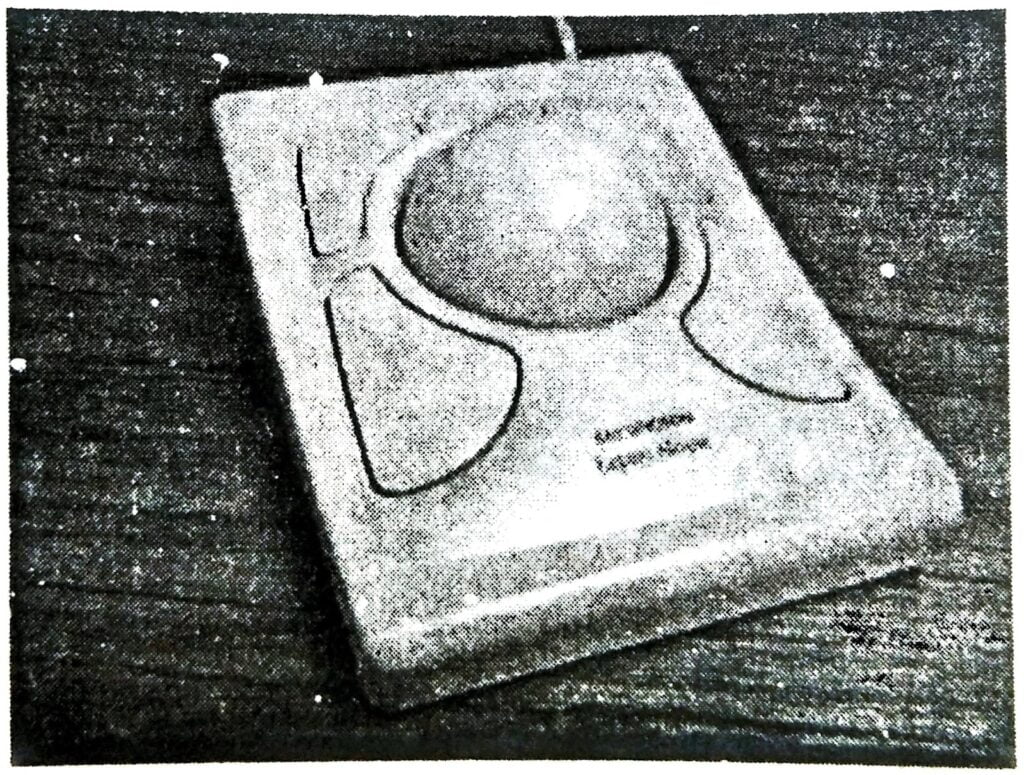
3. Discuss two basic types of monitors CRT and LCD.
Ans. Two basic types of monitor are used with microcomputers, which are as follows:
(i) CRT.
(ii) LCD.
(i) Cathode Ray Tube (CRT): CRT or Cathode Ray Tube Monitor is the typical monitor that we see on a desktop computer. It looks a lot like a television screen and works the same way. This type uses a large vacuum tube, called cathode ray tube (CRT).
(ii) Liquid Crystal Displays (LCD): This type of monitors are also known as flat panel monitor. Most of these employ liquid crystal displays (LCDs) to render images. These days LCD monitor are very popular.
4. What is a software? Discuss its various categories with the help of diagram.
Ans. Software: Computer cannot do anything on its own. It is the user who instructs computer; what to do, how to do and when to do. In order to perform any task, we have to give a set of instructions in a particular sequence to the computer. These sets of instructions are called programs. Software refers to a set of programs that makes the hardware perform a particular set of task in particular order. Software can be classified mainly into following categories and sub-categories are shown in figure below:
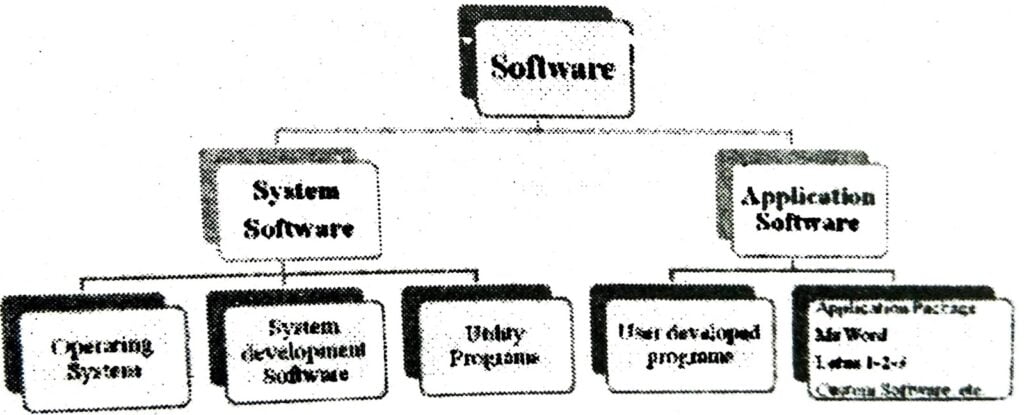
Figure: Classification of Software.
5. Distinguish between system and application software.
Ans. System Software: When we switch on the computer the programs stored in ROM ware executed which activates different units of our computer and makes it ready for we to work on it. This set of programs can be called system software.
System software are sets of programs responsible for running the computer, controlling various operations of computer systems and management of computer resources. Operating System (OS) falls under this category.
An operating system is a system software that provides an interface for a user to communicate with the computer, manages hardware devices (disk drives, keyboard, monitor, etc). manages and maintains disk file systems and supports application programs. Some popular Operating systems are UNIX, Windows and Linux.
Application Software: Application software is a set of programs, which are written to perform specific tasks for example: An application package for managing library known as Library information system is used to manage information of library such as: keeping book details, account holder details, bok issue details, book return details etc. Another application package for managing student details is called student’s information system, manages student’s roll no, name; parents name, address, class, section, processing of examination results etc.
Application software can be broadly classified into two types:
(a) Generalized packages.
(b) Customized packages.
(a) Generalized Packages: These are user friendly software written to cater to user’s very general needs such preparing documents, pictures, database drawing to manage data/information, preparing presentations, play games etc.
It is a group of programs that provide general purpose tools to solve specific problems.
Some of the generalized packages are listed below:
(i) Word Processing Software (for preparing documents): Word perfect, MS-Word, Open office. org Writer.
(ii) Spreadsheets (Data Analysis): Lotus Smart suites, MS-Excel, Open Office.org Calc, Apple Numbers.
(iii) Presentations: Presentation Graphics, MS-Powers Point, Open Office.org Impress.
(iv) Database Management System: MS-Access, Open Office.org Base, MS-SQL Server, ORACLE.
(v) Graphics Tools: Paint shop pro, Adobe
Photoshop.
(b) Custmized Packages: These are the applications that are customized (or developed) to meet the specific requirements of an organization/institution.
For Example: Student information details, Payroll packages, inventory control etc.
These packages are developed using high-level computer language.
6. Write short notes on:
(a) Laser Printer.
(b) High level language.
(c) Compiler.
(d) Plotter.
Ans. (a) Laser Printer: A laser printer produces high quality print that one normally finds in publishing. It is extremely fast and quiet. Moreover, the operation of a laser printer is easy with automatic paper loading and no smudging or messing up of ink ribbons. The fastest laser printer can print up to 200 pages per minute in monochrome (black and white) and up to 100 pages per minute in colour.

(b) High Level Language: High level language has been evolved which uses normal: English like, easy to understand statements to solve any problem. Higher level languages are computer independent and programming becomes quite easy and simple.
(c) Compiler: The software (set of programs) that reads a program written in high level language and translates it into an equivalent program in machine language is called as compiler.
(d) Plotter: A plotter is a special kind of output device that, like a printer, produces images on paper, but does so in a different way. Plotters are designed to produce large drawings or images, such as construction plants for buildings or bluepri nts for mechanical objects. A plotter can be connected to the port normally used by a printer.
An array of different colored pens in a clip rack and a robotic arm is part of plotter. The instructions that a plotter receives from a computer consist of a color and beginning and ending coordinates for a line. With that information, the plotter picks up the appropriate pen through its arm, positions it at the beginning coordinates drops the pen down to the surface of the paper and draws to the ending coordinates. Plotters draw curves by creating a sequence of very short straight lines.
Plotters usually come in two designs:
(i) Flat Bed: Plotters of small size to be kept on table with restriction of paper size.
(ii) Drum: These plotters are of big size using rolls of paper of unlimited length.

Figure: Flat bed and Drum Plotter.
7. Write a note on Computer language and its classification.
Ans. Computer Languages: Languages are a means of communication. Normally people interact with each other through a language. On the same pattern, communication with computers is carried out through a language. This language is understood both by user and the machine. Just as every language like English, Hindi has its grammatical rules; every computer language is bound by rules known as SYNTAX of that language. The user is bound by that syntax while communicating with the computer system.
Computer languages are broadly classified as:
(a) Low level Language: The term low level means closeness to the way in which machine understand.
The low level languages are:
(i) Machine Language: This is the language (in the form of 0’s and 1’s called binary numbers) understood directly by the computer. It is machine dependent. It is difficult to learn and even more difficult to write programs.
(ii) Assembly Language: This is the language where the machine codes comprising of 0’s and 1’s are substituted by symbolic codes (called mnemonics) to improve their understanding. It is the first step to improve programming structure.
Assembly language programming is simpler and less time consuming than machine. level programming, it is easier to locate and correct errors in assembly language than in machine language programs. It is also machine dependent. Programmers must have knowledge of the machine on which the program will run.
(b) High Level Language: High level language has been evolved which uses normal English like, easy to understand statement to solve any problem. Higher level languages are computer independent and programming becomes quite easy and simple.
Various high level languages are given below:
(i) Basic (Beginners All Purpose Symbolic Instruction Code): It is widely used, easy to learn general purpose language. Mainly used in microcomputers in earlier days.
(ii) COBOL (Common Business Oriented language): A standardized language used for commercial applications.
(iii) FORTRAN (Formula Translation): Developed for solving mathematical and scientific problems. One of the most popular languages among scientific community.
(iv) C: Structured programming Language used for all purpose such as scientific application, commercial application, developing games etc.
(v) C++: Popular object oriented programming language, used for general purpose.
Other Important Questions and Answers:
Q. 1. Define the term Control Unit.
Ans. Control Unit (CU): The process of input, output, processing and storage is performed under the supervision of a unit called Control Unit. It decides when to start receiving data, when to stop it, where to store data, etc. It takes care of step-by-step processing of all operations in side the computer.
Q. 2. Write short notes on the Memory System.
Ans. Memory System: There are two kinds of Computer memory: Primary and Secondary. Primary memory is an integral part of the computer system and is accessible directly by the processing unit. RAM is an example of primary memory. Secondary memory is not as fast as primary memory.
Q. 3. Write short notes on the Assembly language.
Ans. Assembly Language: This is the language where the machine codes comprising of O’s and 1’s are substituted by a symbolic codes (called mnemonics) to improve their understanding. It is the first step to improve programming structure. Assembly language programming is simple and less time consuming than machine level programming.
Q. 4. Define the High level language.
Ans. High level Language: High level language is almost English like language, used by human beings for writing programs. These are easier to learn require less time to write programs, provide better documentation and easier to modify.
The main advantage of high level language its portability i.e., any high level language program can be used and executed in almost all computers with little or no change.
Q. 5. What is a Computer?
Ans. Computer refers to an electronic device that accepts data processes it electronically and gives out meaningful information. The computer system can be called as collection of three units (Input, C.P.U., Output) which work in coordination with each other to perform any task.
Q. 6. What are the major components of a computer?
Ans. All general purpose computers require the following hardware components:
(i) Central Processing Unit (CPU): The ‘brain’ of the computer, the component that actually executes instructions.
(ii) Memory: It enables a computer to store, at least temporarily, data and programs.
(iii) Input device: Usually a keyboard or mouse is used to read data and programs into the computer.
(iv) Output device: A display screen, printer etc. that lets you see what the computer has ccomplished.
(v) Mass storage device: It allows a computer to permanently store large amounts of data. Common mass storage devices include disk drive, tape drive, C.D.’s etc.
Q. 7. What is Input device. Write any five input devices.
Ans. Input devices accept data and instructions from the user.
These are the commonly used devices—
(i) Keyboard.
(ii) Mouse.
(iii) Light Pen.
(iv) Optical/Magnetic Scanner.
(v) Track Ball.
Q.8. Define keyboard and mouse as an input device.
Ans. Keyboard: It is the most common input device. The most common keyboard use QWERTY combination of keys. A standard keyboard has 104 Keys. These are numeric keys, arrow keys, special keys, alphabetic keys and function keys.
Mouse: A mouse is an electro mechanical, hand held device and used as a pointer in a computer system.
Q. 9. Define scanner and track ball.
Ans. A scanner translates printed image into an electronic format that can be stored in a computer’s memory.
Some examples of scanner are—
(i) OCR (Optical Character Recognition).
(ii) MICR (Magnetic Ink Character Recognition).
(iii) OMR (Optical Mark Reader).
Track Ball: It is also pointing device like mouse but to move the pointer you have to rotate the ball with your thumb or your fingers. Track ball is stationary and it can be place on any type of surface unlike mouse.
Q. 10. What is output device? Write any five output devices.
Ans. Output devices return the processed data as information, back to the user.
Some common output devices are:
(i) Monitor (V.D.U.).
(ii) Printers.
(iii) Plotters.
(iv) Speakers.
Q. 11. Define monitor and types of monitors.
Ans. It is the most important output device also known as V.D.U. (Visual Display Unit). Information processed within the C.P.U. is needed to be visually displayed, in the same manner as a television displays information, monitor uses the same technique to display information as T.V.
There are two types of monitors:
(i) C.R.T.
(ii) L.C.D.
CRT: It stands for cathode ray tube monitor. It is like typical monitor that looks like a T.V. screen. It has a large vacume tube called cathode ray tube.
LCD: It stands for liquid Crystal Displays monitor. It also called Flat panel monitor. These days L.C.D. monitors are very popular.
Q. 12. Define printer and some most common printers.
Ans. Printer is a most common output device which prints the output on paper as desired.
Some of the most commonly used printers are:
(i) Laser Printers.
(ii) Ink Jet Printers.
(iii) Dot Matrix Printers.
(iv) Line Printers.
Laser Printers: It is an extremely fast and quiet Printer But Costly. It produces High quality print than any other printer. The fastest laser printer can print up to 200 Pages/minute in black and white and up to 100 in colour.
Inkjet Printers: Ink jet printers create image directly on paper by spraying ink by the tiny nozzles. The image quality of inkjet is high but speed is low.
Dot Matrix: It is the most popular printer at one point of time. It is less expensive than any other printer but it is very slower and produces lower print quality.
Q. 13. What is plotter?
Ans. A plotter is a special kind of output device, like a printer. It is used to produce large drawings or images. It is used mainly for flax board of large or small size.
There are two types of Plotters:
(i) Flat Bed Plotter.
(ii) Drum Plotter.
Q. 14. Describe briefly about compiler.
Ans. It checks the entire program line by line for errors and notifies the errors, if any to the user at the end of the program. If the program is error free it translates the complete program.
Entire program
High level program compiler → object → code.
The translation process is performed in two stages. In the first stage, the program is checked for any syntax error. If no error is detected, it translates it into an object code.
However on detection of any error, it should be rectified and the compiler program should be re-executed. The compiler will resume for the start for every subsequent execution.
In the second stage, another program known as run-time monitor translates the program line by line and executes in the same manner and order as an interpreter.

Hi! my Name is Parimal Roy. I have completed my Bachelor’s degree in Philosophy (B.A.) from Silapathar General College. Currently, I am working as an HR Manager at Dev Library. It is a website that provides study materials for students from Class 3 to 12, including SCERT and NCERT notes. It also offers resources for BA, B.Com, B.Sc, and Computer Science, along with postgraduate notes. Besides study materials, the website has novels, eBooks, health and finance articles, biographies, quotes, and more.



